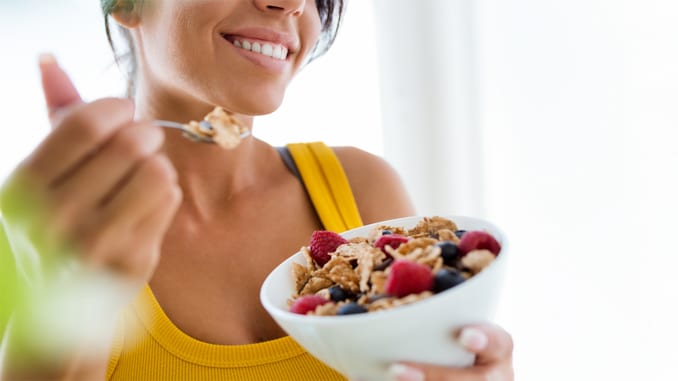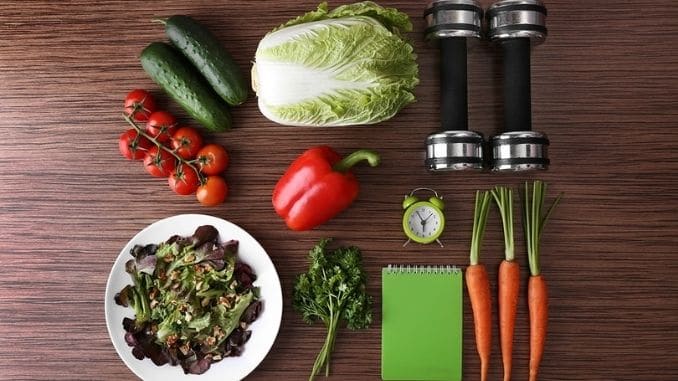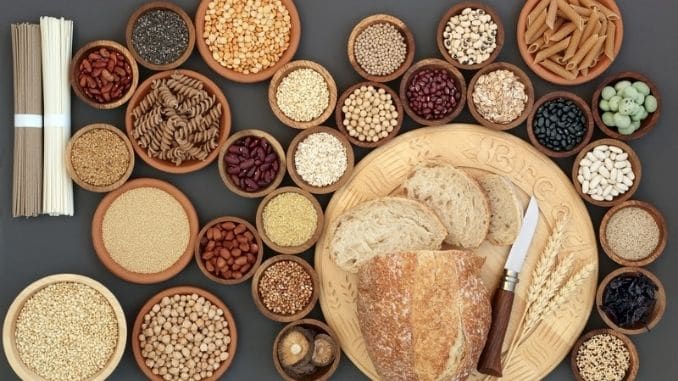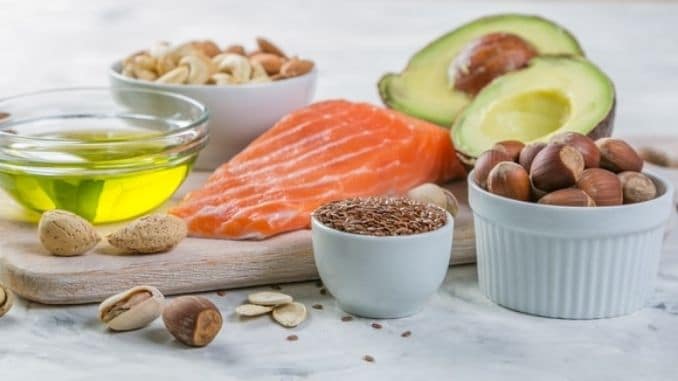
Having just watched the Olympics and witnessing the world’s elite athletes competing in the Winter Games, you might be wondering what kind of diet high-performance athletes need to perform at their peak. Although the very small minority of athletes get the opportunity to compete on the world’s biggest stage, anyone can be a high-performance athlete if they put their mind to it. Whether you run, lift, play a sport or hit the slopes, striving to be your best is inherent and drives you to work harder. Feeding your body the nutrition it needs to excel is vital to getting the results you’re seeking.

Macronutrients
All foods are comprised of three main energy-providing macronutrients ― carbohydrates, proteins and fats ― and are categorized into the one they contain the most of. For example, although they also contain fats, meat and fish are categorized as proteins because they have a higher concentration of protein than any other macronutrient. Your body needs a well-balanced dose of all three macronutrients to sustain a healthy lifestyle. When considering the nutritional needs of high-performing athletes, a deeper look into how your body uses each kind of food is key to ensuring you are feeding yourself properly.
Carbohydrates provide the fuel necessary to perform high-intensity exercises. They’re also the main source of energy used to fuel the central nervous system and aid in the preservation of muscle mass during exercise. Athletic diets should be comprised of approximately 70 percent carbohydrates. Proteins help build various tissue structures in the body including muscle, skin, bones, tendons, and ligaments. Proteins also play a key role in metabolism and hormone function. Competitive athletes should consume about 0.54 to 0.82 grams of protein per pound of body weight daily to rebuild muscle tissue and maintain proper metabolic functioning. More recent science has shown just how important fats are to the human body through decades of food advertising have made “fat” a dirty word. From protecting vital organs and energy reservation to the transportation of fat-soluble vitamins, fats play an important role in human health. About 20 to 35 percent of your daily calories should be sourced from fats while also ensuring that no more than 10 percent are from saturated fats.
A study published in the Clinical Journal of Sport Medicine evaluated the nutritional intake of Canadian high-performance athletes to see if these macro recommendations were being met. This study found that while the athletes made high-quality food choices, both male and female athletes were missing the mark significantly on their carbohydrate intake as well as overall undereating the amount of energy needed to sustain their expenditure. With this in mind, the following food recommendations for high-performance athletes take into account the need for greater carbohydrate intake as well as the need for overall calorically and nutritionally dense foods.
Carbohydrates

The key to quality carbohydrate consumption is fiber. Although carbs have gotten a bad name and many people believe they need to go “low-carb” to look lean, the truth is your body needs ample carbohydrates to perform at a high level. Consuming carbohydrate-rich foods that have high-fiber percentages improves your body’s digestion and prevents blood sugar spikes. Because complex carbs provide long-lasting energy for the body to break down slowly, these foods are best eaten in the hours leading up to high-intensity exercise or the night before major athletic events. Try these sources of carbohydrates that pack a nutritional punch.
Oats
At a whopping 26 grams of protein and 17 grams of fiber per cup, if you haven’t already, oats are a carbohydrate you should get behind. Although traditional oatmeal can be a bit boring, try making some delicious granola or overnight oats flavored with fruits, nuts or chocolate to bring up the interest level and easy accessibility. Better still, blending your rolled oats into oat flour gives you the opportunity to make pancakes, waffles, and muffins that are delicious and nutritious.
Sweet Potatoes
The perfect starch to round out a meal, sweet potatoes offer a colorful, nutritional alternative to white potatoes. Sweet potatoes are loaded with antioxidants, vitamin C and beta-carotene to help stave off illness and keep you in fighting shape. Preparation is key to getting the most benefit from sweet potatoes, so avoid frying them. Try them roasted, baked whole or mashed with different flavorings like cinnamon or sage to keep things interesting.
Brown Rice
Invest a little bit of money in a good rice cooker, and you’ll be so glad that you did. Rice is notoriously tricky to nail perfect cooking execution on, but if you use a handy set-it-and-forget-it rice cooker, you’ll have perfectly cooked rice every time with little to no effort on your part. Choosing brown rice means you are getting the full grain that has not been stripped of its bran and germ as with white rice. This means you are getting the full nutritional value and lots more flavor. Try making colorful Mexican- or Asian-flavored rice bowls with lots of delicious toppings.
Whole Wheat Bread and Pasta
Generally speaking, you want all of your grain sources to be whole. This is easy to do when choosing to eat rolled oats or brown rice because you are literally eating the whole grain. However, when choosing more processed foods like pasta and bread, it can be trickier to ensure you’re getting whole-grain nutrition. Often, similar-looking products are labeled wheat or multigrain but only products labeled as 100-percent whole grain actually use the entire grain for each ingredient included. Choosing the whole-grain alternatives not only provides more flavor but, typically, contains about double the amount of fiber of the more processed, white flour counterparts.
Quinoa
Often thought of as a grain, quinoa is actually a seed that cooks up much like a grain. Quinoa is a complete protein meaning that it contains all 20 amino acids that make up protein strands. Just one cup of cooked quinoa contains 8 grams of protein and 5 grams of fiber making it a foolproof choice as a health-filled carb. Using quinoa in salads, as a replacement for rice or to make veggie burgers are some great ways to incorporate this little seed into everyday life.
Proteins

Lean proteins or proteins that contain high-quality fats are the best way to fuel muscle and other bodily tissue production. A great time to make sure you’re consuming high-protein meals is after strenuous exercise. While carbohydrates help maintain muscle tissue during intense workouts, proteins will help build back any loss that did take place while also working to form new muscle tissue. Here are some of the best protein sources for high-performance athletes.
Salmon
One of the most well-rounded proteins you can eat is salmon. With 35 to 40 grams of protein per 5-ounce serving and super heart-healthy omega-3 fatty acids, you’ll be hard pressed to find an animal protein that does more good for your body. Even if you are not a seafood lover, most people find that salmon is a mild-tasting fish that tastes great grilled or broiled. If access to fresh seafood presents a problem, frozen options can usually serve as a suitable replacement.
Eggs
Eggs are a great protein source as well as providing a multitude of important nutrients to the body like folate, iron, and vitamins A, D and E. Eggs got a bad name for a while because of that scary “fat” word mentioned earlier, but there’s no reason to be afraid of the humble egg. Make sure you eat the whole egg as the majority of the nutritional value lies in the yummy, yellow center. Eggs can be a great cost-effective dinner or lunch protein by making omelets or frittatas filled with vegetables.
Beans & Legumes
Incorporating more beans and legumes into your diet can increase your protein intake without breaking the bank. Plant-based protein is also a terrific way to make sure you are getting well-rounded sources of protein that bring more to the table than just the protein itself. Some of the most protein-packed options are soybeans, lentils, pinto beans, and black beans. Try stocking up on some of your favorites and mixing them into pasta, salads or rice bowls.
Nuts or Nut Butters
Another awesome plant-based protein that also provides a punch of healthy fats is nuts and/or nut butter. Almonds, walnuts, and peanuts are all excellent nut choices. Be sure to select nut butter that has the least number of ingredients to avoid excess salt and sugar. Whether you like to spread it on toast or apples or blend it into a smoothie, finding ways to eat more nuts is a terrific choice for your heart health and protein consumption.
Fats
https://www.bigstockphoto.com/image-203646949/stock-photo-brown-flax-seeds-in-spoon-and-flaxseed-oil-in-glass-bottle-on-white-wooden-background-flax-oil-is-rich-in-omega-3-fatty-acid
Healthy fats are vital to maintaining a healthy body. Part of the disconnect between fat consumption and health is the lack of separation between good fats and bad fats. In short, not all fats are bad for you, and many of them are very good for you. Avoid overdoing animal-based fat sources and focus on these healthier alternatives.
Flaxseed
Flaxseed is a superb source of those omega-3 fatty acids that do great things for your heart and your body as a whole. Incorporating them into your daily routine can be a great way to ensure that your healthful diet consists of enough quality fat. Try sprinkling them into salads, mixing them into granola or blending them into smoothies. You can probably throw them into just about anything, and you won’t even notice.
Soybean Oil
A great “everyday” oil choice is soybean oil. Soybean oil is a plant-based fat that makes for a more nutritional and flavorless alternative to other fats. Great as basic cooking oil, remember to use soybean oil for things like stir-fried veggies or searing meats. As with any oil, you should remember to use sparingly as only about 30 to 35 percent of your daily calorie intake should come from fat.
Bonus: Chocolate Milk
It sounds too good to be true, doesn’t it? However, studies have shown that athletes who consume chocolate milk as opposed to sports drinks after high-intensity workouts recover more quickly. Your body will consume the high-carbohydrate concentration quickly after strenuous exercise and use the high-protein content to begin rebuilding muscle fibers. Plus, you’re getting to drink chocolate milk. That’s a win-win in any situation.
For your guide to the best foods to heal and slim your body, check out The Best Foods that Rapidly Slim & Heal in 7 Days, here!

